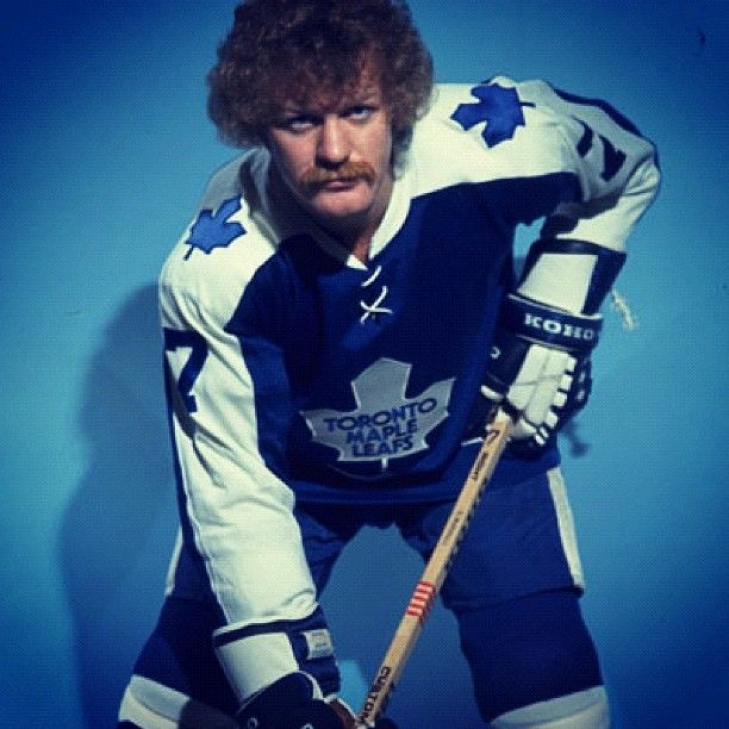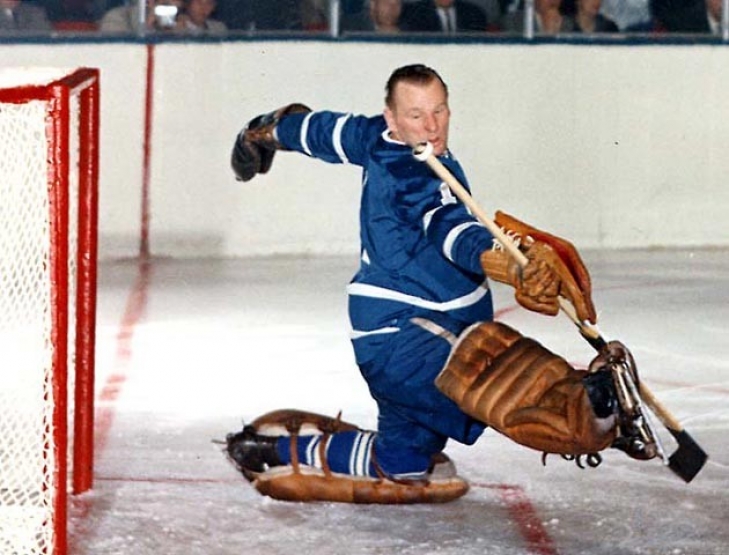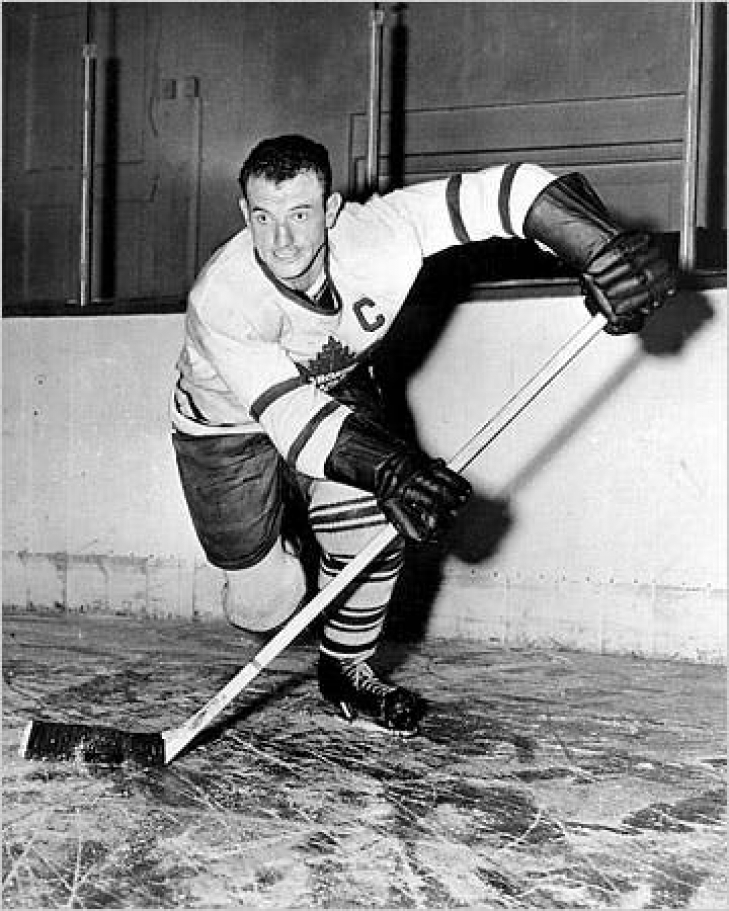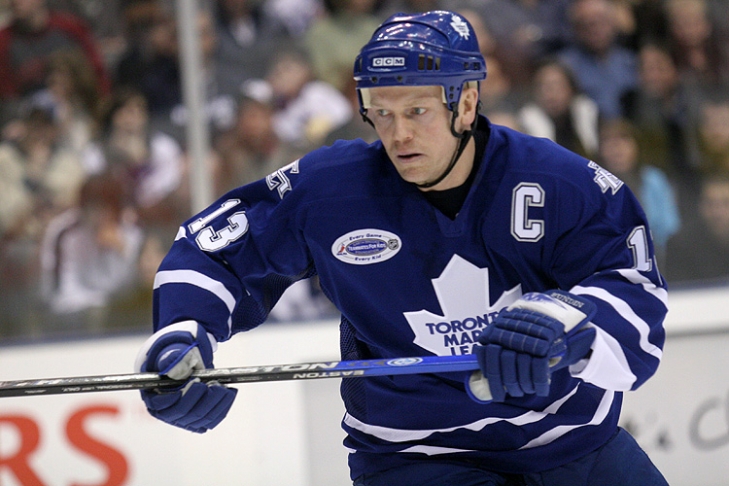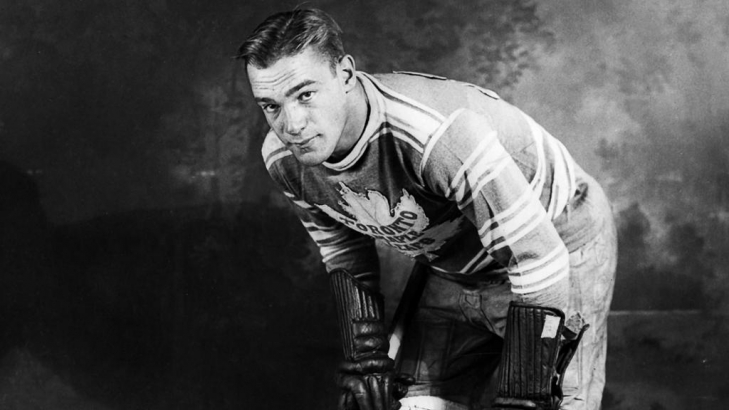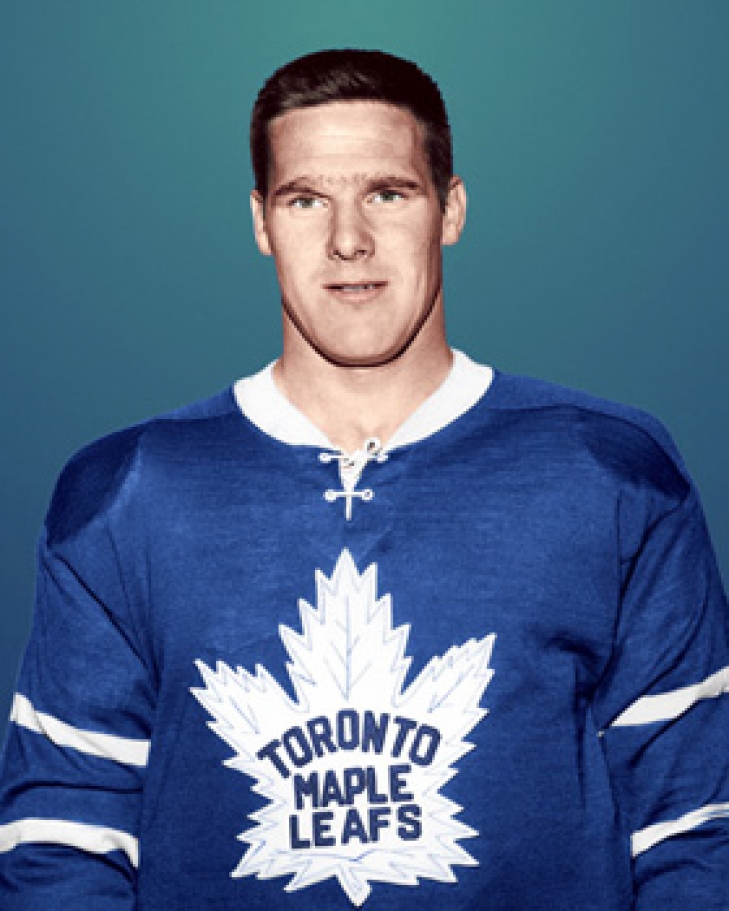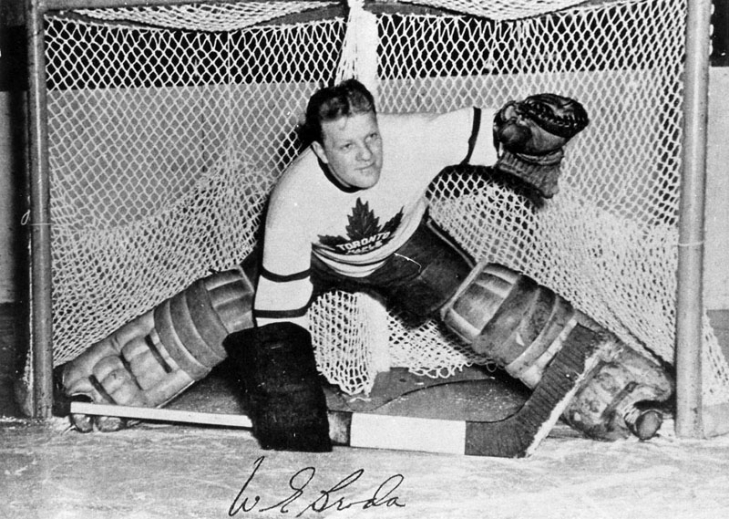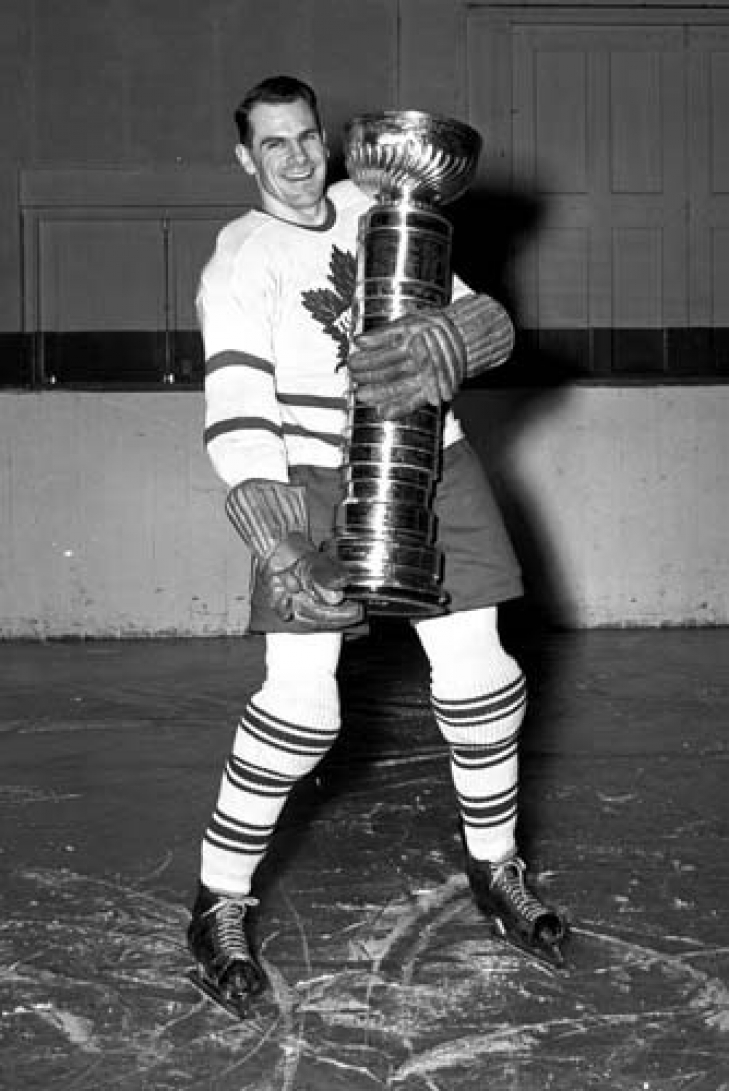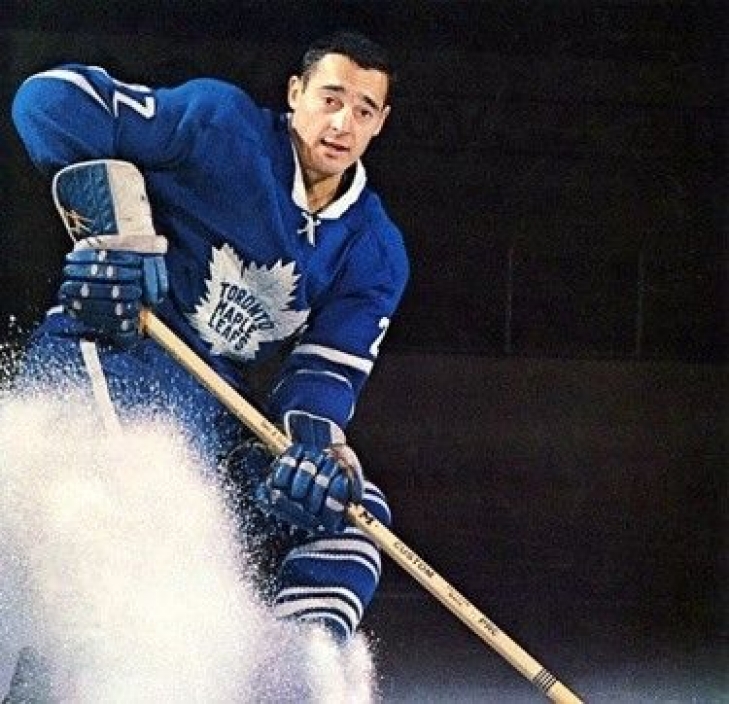22. Lanny McDonald
Taken with the fourth overall pick in the 1973 Draft, Lanny McDonald made the Toronto Maple Leafs that year, and two seasons later, the mustached one was one of the snipers in hockey.
The Right Wing would be on a line with Darryl Sittler, and the two lit up the league. McDonald was a Second Team All-Star in 1976-77, scoring 46 Goals, which began a four-year streak hitting the 40-Goal plateau. His most famous goal occurred in the 1978 Playoffs, where he put the puck in the net in the series clincher against the heavily favored New York Islanders.
McDonald would be used as a pawn in the feud between Sittler and Maple Leafs’ owner, Harold Ballard, as he was traded to the Colorado Rockies during the 1979/80 season. He would later join the Calgary Flames and win the Stanley Cup in 1989, which was McDonald's final season.
With the Maple Leafs, McDonald had 219 of his career 500 Goals. He was elected to the Hockey Hall of Fame in 1992 in his first year of eligibility.
21. Ace Bailey
Irvine “Ace” Bailey was not planning to turn his hockey playing into a professional career, and in the 1920s, that was not considered a lucrative option. The Toronto St. Patricks saw an abundance of talent in Bailey, and he signed with them before the 1926/27 season.
Bailey was an instant star, utilizing his marksmanship and speed to become one of the premier snipers in hockey. Bailey would lead the NHL in Goals in 1928-29 (22) and Points (32), and he had two more 20-Goal/40-Point years, which was an impressive accomplishment back then.
On December 12, 1933, the Leafs were on the road against Eddie Shore and the Boston Bruins. During the game, the tenacious King Clancy checked Shore with brute force, leading the Bruin to seek vengeance. Shore got up, and with the Leafs advancing to the Boston zone, he used his stick to viciously trip Bailey (who he thought was Clancy), who thunderously fell to the ice head-first.
Bailey was not just knocked out cold; he was in a coma for ten days, of which it was thought he would never recover. Bailey came out of the coma, but his playing career was over. To help Bailey financially, an All-Star Game, the first of its kind in the NHL, happened in 1934, with Shore and Bailey shaking hands to start the game.
The Maple Leafs honored Bailey and made history in the process by becoming the first NHL team to retire a number when Bailey’s number 6 was retired.
Bailey was finally elected to the Hockey Hall of Fame in 1975.
20. Gordie Drillon
The professional hockey career of Gordie Drillon was relatively short, considering that he would eventually become a Hockey Hall of Famer, but he created an offensive strategy that would become a staple in the NHL.
Called up in 1936, Drillon was a Right Wing who used his size to position himself in front of the opponent’s net. Drillon redirected shots and tipped them into light the lamp. It worked, as Drillon led the NHL in Goals (26) and Points (52) in his second season (1937-38) and was a First Team All-Star. Drillon would also win the Lady Byng that year with only four Penalty Minutes accrued.
Drillon continued to dazzle offensively, earning First Team honors in 1938-39, and was a Second Team All-Star selection in 1941-42. With the Leafs he had four 20-Goal seasons, which was excellent in an era where they played less than 50 Games.
What Drillon failed at was defense, as he was not very committed to the back end. Drillon was a member of the Toronto team that won the 1942 Stanley Cup, but he saw less action in the second half of the series, where Toronto overcame a 3-0 deficit to Detroit. Drillon was shipped off to Montreal after the Cup win.
After one year with the Habs, Drillon joined the Canadian military to serve in World War II. While he returned to play hockey after the war was over, his skills were no longer good enough to play in the NHL.
Drillon entered the Hockey Hall of Fame in 1975, on the strength of his play in Toronto, which saw him average .93 Points per Game. His attention to defense may have been lacking, but his offensive innovation still resonates in hockey today.
19. Red Horner
Playing at Defense, Red Horner was an 11-year veteran of the National Hockey League, all of which was as a Toronto Maple Leaf.
Horner was a meat-and-potatoes type of player who had no grace on the ice but effortlessly found teammates whit precision passing. His true calling card was his toughness, as evidenced by leading the NHL in Penalty Minutes seven times. Horner helped the Maple Leafs win the 1932 Stanley Cup, and his rock-solid defensive skills were a huge asset to Toronto.
Horner was chosen for the Hockey Hall of Fame in 1965.
15. George Armstrong
Known as “Chief” due to his Algonquin heritage, George Armstrong would become the most tenured Toronto Maple Leaf of all time, participating in 1,188 Games.
Armstrong first appeared in a Leafs uniform in the 1949-50 Season, and was a stalwart at Right Wing two years later. While he was not a gifted skater, he had a high hockey IQ, expert positioning and rarely lost a grind in the corner.
Armstrong was not a potent scorer but was the most consistent player for a 15-year period. His career-high in Points was only 53 (1961-62), but he cracked the 40-Point mark seven times, and he was very good on the defensive side of the ice. Armstrong became the team captain in 1957 and held that post for twelve seasons, overseeing four Stanley Cups, arguably making him the most successful Maple Leaf to don the "C."
Retiring after the 1970-71 Season, Armstrong scored 726 Points and remains one of the most respected players in franchise history.
Armstrong was chosen for the Hockey Hall of Fame in 1975, and the Leafs hung his likeness to the rafters of the Air Canada Center in 1998. His number 10 (along with Syl Apps) was retired in 2016.
13. Johnny Bower
A product of rural Saskatchewan, Johnny Bower first made the NHL with the New York Rangers at age 29, where he played every minute in his rookie year (1953-54). The Goalie lost his job to Gump Worsley, and he would be relegated to the minors until the Maple Leafs took him from Cleveland of the AHL in 1958. At age 34, he was about to put forth an unexpected Hall of Fame run.
Bower remained with the Maple Leafs into his mid-40s, and he was not there to ride the pine but to provide the netminding necessary to bring Toronto to playoff dominance. In the 1960-61 Season, Bower won the Vezina Trophy, was a First Team All-Star, and backstopped the Leafs to three straight Stanley Cup wins. He followed it up with a second Vezina in 1965.
After his second Vezina, Bower’s eyesight began to fail, yet his grit kept him in the NHL. Bower, who was fearless, even in his era, helped the Leafs win another Cup in 1967, though fellow veteran, Terry Sawchuk, was the primary Goalie. He played until 45 and had 219 Wins with Toronto.
Bower was inducted into the Hockey Hall of Fame in 1976. In 1995, his name was hung to the rafters of the Air Canada Center, and his #1 (shared with Turk Broda) was retired by the franchise.
12. Dave Keon
Dave Keon made an immediate impact in the National Hockey League, making the Toronto Maple Leafs straight out of junior. Keon scored 45 Points, winning the Calder Trophy, and his solid two-way play made him an instant celebrity in Toronto.
The Center had an effortless backhand and a booming shot. As good as his offense was, Keon was one of the best offensive defensemen of the 1960s and a demon on the penalty kill. A two-time Second Team All-Star, Keon twice led the NHL in Short-Handed Goals (1968-69 & 1970-71) and had 31 in total with the Leafs. Incredibly, that number is not as impressive as the 75 total Penalty Minutes in the 1,062 Games he played in Toronto.
Keon won the Lady Byng Trophy as the NHL’s most gentlemanly player twice (1962 & 1963) and was in the top four in voting seven other times. The Maple Leafs won four Stanley Cups in the 1960s, with Keon playing a vital role in all of these wins, peaking with a Conn Smythe Trophy in the 1967 win.
In the 1970s, Keon feuded with Toronto owner Harold Ballard, who held his rights after his contract expired in 1975. Since Ballard set unreasonable terms for compensation, Keon had to continue his career in the WHA. It would be decades before he would ever reenter the Leafs fold in any capacity.
Keon was chosen for the Hockey Hall of Fame in 1986. Keon would not accept having his name honored by the team, but his number 14 was retired by the team in 2016.
10. Ted Kennedy
There are so many former Maple Leafs who fans and writers have dubbed as the consummate representative of the team. One that comes up often, and certainly did in his day, was Ted Kennedy.
Kennedy played his entire NHL career for Toronto, debuting as a teenager in 1943 and scoring 49 Points in 1943-44 and 54 Points in 1944-45, with the latter season earning Kennedy and the Maple Leafs win the Stanley Cup. Kennedy had arrived, leading all skaters in Goals (7) in the playoffs, and his two-way skills and selfless play endeared him to his teammates and coaches alike.
Toronto would win three straight Cups (1947-49), with Kennedy being a key performer in all of them. It was as though he saved his best performances when it mattered the most, and he lit the lamp twice in the Cup-winning game in 1948. Kennedy and the Leafs were considered one of the first dynasties in the NHL, and while he was not the top star, he was the glue.
In 1949-50, Kennedy again had a decent year, but the playoff semi-final against Detroit saw the Center injure the Red Wings’ up-and-coming star, Gordie Howe, on a botched check. Some believed (including the Red Wings) that Kennedy did this on purpose, and it invigorated Detroit who upset the Leafs. Kennedy would, however lead Toronto to a Stanley Cup win the following season, his fifth overall.
In the 1950s, Kennedy's production remained the same, but his individual trophy case gained accolades. Kennedy was a Second Team All-Star in 11950, 1951, and 1954, and even though he was not a post-season All-Star in 1954-55, he was named the Hart Trophy winner. With all due respect to Kennedy, he likely should not have won the award, as it was more of a lifetime achievement honor, more than actual recognition of what he accomplished that season. Kennedy retired after that year but did return a year later for 30 Games before retiring for good.
He overall had 560 Points in 696 Games with another 60 in 78 Playoff Games.
Kennedy was elected to the Hockey Hall of Fame in 1966, and in 1993, he was part of the prestigious group that was honored by the Leafs with a banner. His number 9 was retired (along with Charlie Conacher) in 2016.
9. Mats Sundin
Mats Sundin played four seasons with the Quebec Nordiques before he was traded to the Toronto Maple Leafs in the transaction that sent Wendel Clark the other way. It was a tough start for Sundin in Toronto, as Clark’s popularity in Toronto was astronomical, but Sundin proved quickly that Toronto won the trade.
Sundin could not match the 114 Points he scored in the 1992-93 season as a Nordique, but the rules changed that favored a more defensive game, and he was still a Point-per-Game player with Toronto. From 1995-96 to his final year in Toronto, 2007-08, Sundin scored at least 70 Points and would lead the Leafs in scoring eight times. The Swedish Center would be a two-time Second Team All-Star and was arguably the face of the franchise for a decade. Toronto might not have won or even made a Stanley Cup when Sundin was their leader, but any player at the top of their food chain for an Original Six team is a legendary figure.
Sundin entered the Hockey Hall of Fame in 2012, which would be the same year his name was added to honored players at the ACC. The Maple Leafs retired his number #13 in 2016.
5. Borje Salming
Borje Salming was not just one of the first hockey players from Scandinavia to play in the NHL, but the Swedish Defenseman was the first from his region to emerge as a superstar on the NHL level.
Salming signed with Toronto in 1973, but not much was expected as the NHL and North America generally viewed Europeans as soft and unable to maintain the rigors of their league. Salming immediately proved the naysayers wrong, scoring 39 Points as a rookie and finishing fifth for the Norris.
In the six years that followed, Salming was either a Second Team or First All-Star, and while he was never a Norris Trophy winner, he was never lower than fourth in the voting. From 1976-77 to 1979-80, Salming netted at least 70 Points, and he forever changed the perception of what Europeans could accomplish in the NHL.
Salming played with Toronto until the 1988-89 season, and he had one final year in the NHL as a Detroit Red Wing. With the Leafs, Salming played 1,099 Games, scoring 787 Points.
Salming’s overall play in the NHL laid the groundwork that other Swedish and European players followed. He entered the Hockey Hall of Fame in 1996, and his name was honored at Air Canada Center in 2006. Ten years later, his #21 was officially retired by the team.
4. Charlie Conacher
A strong argument can be made that the first true power forward in hockey was Charlie Conacher, and at the very least, he was one of the first to define the role.
Conacher was a dynamo in junior, leading the Toronto Marlboros to two Memorial Cup wins (1928 & 1929). Conacher stayed in Toronto as a pro, signing with the Maple Leafs, and he rapidly became a star, scoring a goal in the opening game in the 1929-30 season.
The Canadian earned the nickname of the “Big Bomber," using his strength and powerful shot to terrorize opposing netminders. Taking Toronto to a Stanley Cup in 1932, Conacher became the first player to lead the NHL in Goals five times, and he was also a First Team All-Star three times and a Second Team All-Star twice. Conacher was also the runner-up for the Hart Trophy in 1934-35 and was a two-time scoring champion. Considered to be the top Right Wing in the first half of the 1930s, his bruising style caught up with him, and injuries piled up.
Conacher was traded to the Detroit Red Wings, and as a Maple Leaf, he scored nearly a Point per Game (324 Points in 328 Games).
Conacher entered the Hockey Hall of Fame in 1961, and he was part of the group that had a banner honored by the Leafs in 1998. His #9 (along with Ted Kennedy) was officially retired by Toronto in 2016.
3. Tim Horton
Tim Horton played his first 20 Seasons in the NHL with the Toronto Maple Leafs, where his physical strength and toughness set him apart from the other Defenseman.
Horton debuted in 1950 and was a Second Team All-Star in 1952-53. He could drop the gloves and intimidate when needed, though he was not a player who drew penalties, often considering his physical style of play. Horton had a phenomenal decade in the 1960s, where he anchored Toronto to four Stanley Cups, was a First Team All-Star twice, and a Second Team All-Star three times. Horton finished in the top-four in Norris voting six times and was the runner-up twice.
In 13 different years in Toronto, Horton was in the top ten in Defensive Point Shares, and he led the league in that advanced metric twice (1953-54 & 1962-63). As of this writing, he is seventh all-time in DPS.
Horton was traded to the New York Rangers in 1970, and he later played for Pittsburgh and Buffalo, where his career ended following his death from a car accident. He was elected to the Hockey Hall of Fame in 1977, with the Leafs honoring him in 1995. His number #7, which he had sometime after fellow honoree, King Clancy was officially retired in 2016
2. Turk Broda
Turk Broda played his entire NHL career with the Toronto Maple Leafs, and with all due respect to everyone else who wore the blue and white in between the pipes, it is Broda who is the most important.
Broda’s professional career began with the Detroit Olympics in the minor leagues, but his path to the NHL would not remain in the Motor City. The Olympics sold his contract to his hometown Maple Leafs, and he would become Toronto’s starting Goalie going into the 1936-37 season.
The Torontonian proved to be a top Goalie, and in the 1940-41 season, Broda won his first Vezina and would lead the Maple Leafs to a Stanley Cup win the year after. It was a special championship in sports, as the Maple Leafs became the first team to overcome a 3-0 Finals deficit to win the title. Broda’s work on the ice took a two-and-a-half-year detour due to World War II, but he returned better than ever.
Broda led Toronto to four Stanley Cups (1947, 1948, 1949 & 1951) in five years, winning a second Vezina in 1948. Age caught up to Broda in 1951, as he played in only 31 Games, and after appearing in only one contest in 1951-52, he retired from hockey with a career record of 304-222-102.
Broda was inducted into the Hockey Hall of Fame in 1967, and in 1995, his banner was hung to the ACC's rafters. Toronto officially retired his number #1 in 2016.
1. Syl Apps
If you look at the top ten that we came up with, we could make a case for any one of them as the best Toronto Maple Leaf of all time. Not only that, when you have a team with a long history and fervent fanbase of Toronto, you will likely find a list that has one of those men at the top. After what felt like weeks of analysis, we settled on Syl Apps as the greatest Maple Leaf ever.
Apps was an outstanding athlete who won the Gold Medal at the 1934 British Empire Games and would later be sixth at the 1936 Olympics. The multi-sport athlete was courted by the Toronto Maple Leafs to play, and he made immediate history as the first-ever Calder Trophy winner as the NHL's best rookie.
As a rookie, Apps led the NHL in Assists and did so again in his second NHL season. While the Center never won the Hart, from 1938-39 to 1942-43, he was either second or third in the balloting for the most coveted individual trophy in hockey. Apps also led Toronto to a Stanley Cup win in 1942.
Apps missed two seasons as he joined the Canadian Military for World War II, and the Center came back, still an elite player, where he led the Leafs to Stanley Cups in 1947 and 1948. The ’48 Cup win would be his final game in the NHL, ending a ten-year run all with Toronto.
Amazingly, he only had 56 Penalty Minutes over his career, and as such, Apps won the Lady Byng in 1942, was the runner-up for it twice, and the second runner-up another two times. While we again concede that there were others who could easily slide in at the top here, can anyone state emphatically that Apps shouldn't be number one? Not emphatically. Not a chance.
And, yes, we think we would have written those last three sentences had we gone with one of the others we considered for number one. This is how tight it was.
Apps entered the Hockey Hall of Fame in 1961, and his name was one of the first honored in the Air Canada Center in 1993. In 2016, his number 10 (which George Armstrong also had) was officially retired by the Leafs.
14. Frank Mahovlich
Frank Mahovlich entered the NHL with lofty expectations, and he delivered immediately, winning the Calder Trophy as the best rookie in the 1956-57 Season.
The “Big M” built on his skills, becoming one of Toronto’s top offensive threat in the 1960s. In the 1960-61 campaign, Mahovlich scored 84 Points, which would be a personal best in Toronto, and he led the league in Even Strength Goals (41). Mahovlich was named a First Team All-Star that year, and he would help lead the Maple Leafs to the first of three straight Stanley Cup wins.
After his first Cup, Mahovlich was named a First Team All-Star in 1963 and had Second Team honors in 1962, 1964, 1965 & 1966. The Left Wing again helped them win another Cup in 1967. This added up to a substantial amount of success, but management would sour on the star like so many Leafs.
For Mahovlich, Punch Imlach, Toronto’s Head Coach and Executive, was the bane of his existence. Imlach constantly berated Mahovlich, who in modern terms suffered severe mental health issues because of it. Allegedly, the two did not speak for the last five years of his time in Toronto, which ended in a trade to the Detroit Red Wings in March of 1968.
Mahovlich would later win two more Stanley Cups with the Montreal Canadiens, but he was always best known for his time as a Maple Leaf despite the issues with Toronto. With the Leafs, Mahovlich scored 597 Points in 720 Games.
Mahovlich entered the Hockey Hall of Fame in 1981, and he had a banner raised in 2001. His number 27 (along with Darryl Sittler) was retired by the organization in 2016.
11. Busher Jackson
When you are in the Hockey Hall of Fame, it is hard to call you underrated, but in the lore of the Toronto Maple Leafs, Harvey “Busher” Jackson does not nearly receive the due he is deserved.
Jackson was the top Left Wing in hockey, where he starred on the “Kid Line” along with Charlie Conacher and Joe Primeau. Leading Toronto to a Stanley Cup in 1933, Jackson was four-time First Team All-Star, who finished in the top-six in Goals five times. Jackson would lead the NHL in Points in 1931-32 and was the runner-up the year after.
Jackson was known for a blistering backhand, and at times, a cocky attitude. It did not always serve him well, but he backed it up on the ice. After his play slipped, he was traded to the New York Americans for Sweeney Schriner.
With the Leafs, Jackson scored 351 Points in 433 Games, and he entered the Hockey Hall of Fame in 1971.
132. Gus Mortson
When you have a nickname of “Old Hardrock” you kind of get an idea of just what type of Defenseman that Gus Mortson was. From Northern Ontario he was paired with another youngster in Jim Thomson and they would become the ”Gold Dust Twins”.
206. Felix Potvin
123. Ron Ellis
71. Bob Baun
Bobby Baun reminds us a lot of Paul Henderson in that he is best known for one game. Baun fractured his ankle early in Game 3 of the 1964 Stanley Cup Championship but returned to the ice to score the game-winning goal against the Detroit Red Wings and would help Toronto win the Cup that year.


